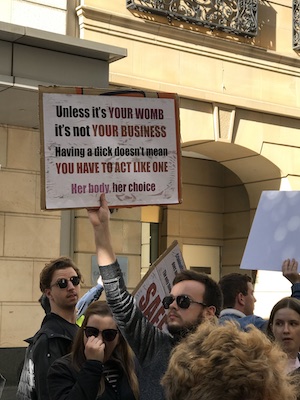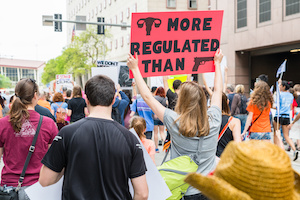All over the world right now, there’s a war raging. It’s a war over women’s right to body autonomy, bodily autonomy and bodily integrity. We don’t call it a war, but we should.
Body autonomy
Body autonomy, here, is used to refer to a woman’s right to choose what she may do with her own body. That covers a wide territory from how to dress, whether to adorn herself or wear tattoos, whether and when to be sexual, who to be sexual with, whether to partner, who to partner with, whether and when to have children, and how many; and being free from genital mutilation.
I want to also include being safe from violence in the face of a girl or woman’s choices under the heading of bodily autonomy.
As I write this, I’m struck by how utopian this sounds.
Right now, Indonesia is passing laws forbidding the use of birth control and making sex outside of marriage illegal. I rest my case.
A world against women’s bodily autonomy
All over the world, for centuries to the present day, cultures have institutionalised male control over women’s bodily autonomy and rigorously enforced those laws.
For centuries, women were considered to be part of a man’s goods and chattels in most cultures. There was virtually no possibility for women and girls to have any say over their lives, much less their bodies.
Today, this is still the case for many women and girls in many countries. Girls are married off in arranged marriages as children, expected to start bearing children as soon as possible. As a result, many girls die in childbirth. Girls are traded for goods, services, favours, to pay off debts, and secure alliances. Girls are prevented from receiving an education. Female genital mutilation is still a thing in too many cultures.

In such contexts, there is no question of girls having any right to bodily autonomy. Before you start to think child marriage only happens in less developed countries, let me say this. In the United States, all States permit child marriage under the statutory age limit with parental consent or judicial authorisation.
Over the past 15 years, “more than 200,000 minors married in US, and in Tennessee girls as young as 10 were married in 2001, before the State set a minimum age of 17 in 2018.”[i]
In Australia, children, mostly girls, as young as six years old are being forced into child marriage. In Australia, more than 100 cases of forced child marriage were being investigated by the Australian Federal Police in February 2019. It is thought that these figures are just the tip of the iceberg[ii].
Exercising choice is dangerous for women
Even in so-called developed nations, women’s right to bodily autonomy continues to be a fiercely contested issue. Every week, all over the world, a number of women are assaulted or killed for daring to make choices with their lives, with their bodies, that men around them object to. In Australia, on average, one woman a week is murdered by her current or former partner. Between one-in-four and one-in-six women experience emotional, physical, or sexual violence by a current or former partner. Making choices about their lives, let alone their bodies, comes at great cost for women.
In some cultures, the practice of so-called honour killing is seen as a reasonable solution to what is seen as a woman’s transgression of stepping outside the prescriptions and prohibitions laid down for them by men. But it is not only some cultures that accept the use of violence to ‘correct’ so-called breaches of male and family honour. In Australia, when we consider that one woman a week is murdered by her current or former partner, it could be said that we have our own version of so-called honour killings[iii].
Recent regressive moves
In Western cultures, the war over women’s rights to bodily autonomy continues to rage over the issue of access to safe abortion services.

Although many Western nations have passed abortion laws enabling women to access safe, legal abortion, so-called conservative religious elements continue to wage war on the gains that have been made. As I started to write this article, these people pushed to keep archaic laws criminalising abortion in New South Wales, Australia, and trying, in fact, to make accessing abortion even harder.
In the United States, over the last year, we have seen the passing of a number of so-called heartbeat laws – based on the erroneous notion that, if a clump of cells is known to demonstrate a pulsing electrical rhythm, that ‘counts’ as a “heartbeat” – even though the cells are not viable outside of the woman’s body[iv].
On that false premise, under these laws, pregnant women are being forced to proceed with pregnancies no matter what – even if the pregnancy resulted from rape or incest, even if it endangers the woman’s life.
In passing such laws, legislators – let’s face it, most often, male – are effectively claiming that women have no reproductive rights – that we are merely incubators of future human beings.
In 2019, I have watched in horror as a repressive tide against women’s body autonomy steadily creeps across the US. By May 2019, nine States had passed so-called “heartbeat laws”, making it an offence to procure an abortion or to provide one. One State tried to criminalise women going interstate to obtain an abortion. Alabama tacked on a clause within the legislation making it a criminal offence for a woman to report a rape if, once it goes to trial, it does not result in a guilty finding.
Make no mistake – there is a war against women, and women’s efforts to gain body autonomy as a right.
Making abortion as hard to access as possible
In addition to making accessing abortion a criminal offence, even if abortion is sometimes accessible, legislators put all sorts of restrictions and obstacles in women’s path to deter them from accessing that choice, or at least, making it more difficult. The strategies used are the same everywhere.
Restrictive clauses put in place in the United States include[v] –
- Physician and Hospital Requirements: requiring a termination to take place in a hospital at a certain point, and sometimes, for a second physician to be present;
- Gestational Limits: prohibiting abortions generally, except when necessary to protect the woman’s life or health, after a specified point in pregnancy.
- “Partial-Birth” Abortion: placing an abortion ban and restricting late-term abortion, so-called “partial-birth” abortion, typically after the foetus is considered to be viable.
- Making the cost of abortion prohibitive e.g. in the US, through restricted State funding, restricting health insurance funding, or making coverage available only at an additional cost.
- Refusal: allowing providers and health institutions to refuse to perform abortions or limiting refusal to private or religious institutions.
- State-Mandated Counselling: mandating that women be given counselling before an abortion that includes information on at least one of the following: the purported link between abortion and breast cancer (five States), the ability of a foetus to feel pain (13 States) or long-term mental health consequences for the woman (eight States).
- Waiting Periods: requiring a woman seeking an abortion to wait a specified period of time, usually 24 hours, between when she receives counselling and the procedure is performed. In the US, some States have laws that effectively require the woman make two separate trips to the clinic to obtain the procedure, making the whole process both more stressful for the woman, as well as more costly.
The state of play in New South Wales
In New South Wales this year, we saw exactly the same attempts being made by so-called conservative forces to restrict women from having any abortion rights. The debate was framed as –
- Abortion being equated with ‘murder’ (despite the cells not being viable for many weeks outside of a woman’s body), and thus a criminal act;
- women making the choice to abort on frivolous terms (they do not);
- women seeking to abort at late-term in pregnancy on frivolous terms (instead of due to grave medical reasons);
- women needing ‘counselling’ and being required to wait through extra waiting periods, as though they are not able to make their own decisions and do so without having carefully thought through the issues long before making their choice;
- thinly-veiled racist terms, as it was claimed that certain cultures (typically, the focus was on Asian and Muslim cultures) were claimed to be more likely to seek out gender-based abortions.
Usually, proponents of such laws are self-proclaimed Christians, and scream loudly that they are there to protect the human rights of the ‘unborn child’. We heard virtue signalling from so-called Christians on this issue, even as they paid scant attention to women’s health needs, the reality of how hard it is to bring up a child with a severe genetic disability, or a child that was conceived out of violence such as rape or other coercion, the reality that contraceptive failure exists, let alone the fact that women want and should have the right to be able to determine whether they wish to bear a foetus to term or not.
The common thread through the debates that took place in New South Wales is that anti-choice/anti-women proponents do not consider that women have a human right to decide whether to proceed with a pregnancy purely on the basis of it occurring in their bodies.
For these people, a woman’s body is not her own from the moment she carries a fertilised ovum.

Bad women and invisible men
So-called pro-life advocates (I prefer, anti-women lobbyists) promote all sorts of lies about the women who go through the difficult decision process of having an abortion and make out that women cannot be trusted to make this choice for themselves. Lies and misinformation abound. Women are painted as frivolous, selfish, callous, amoral, pleasure-seeking creatures who want to shirk their responsibilities and not deal with the consequences of their actions (presumably, having sex that results in a pregnancy).
The males who, presumably, are a party to this tide of unwanted pregnancies were not referred to anywhere. There was no talk of mandatory DNA testing, or men being forced to be identified as the biological fathers, or them being required to support such children if the pregnancies are brought to term. There was no talk of men having to get vasectomised in order to avoid the risk of unwanted pregnancy, until such time as they elect to have children. At no point were men, the sperm component of the fertilised ovum, painted as evil, irresponsible or callous for not raising their young. The invisible male is invisible precisely because he does not have to be there to deal with any of the consequences of an unwanted pregnancy – not at a body level, at a life-choice level, nor does he need to deal with this on a lifelong basis.
Despite this invisibility, male voices dominated in pushing the anti-women/anti-body autonomy agenda in Parliament and in the media.
Democracy? Whose interests are being served?
In New South Wales, as we headed for this latest reform, we knew that 71% of voters support having abortion removed from the Crimes Act. One wouldn’t know that based on the way anti-women lobbyists held all women in New South Wales to ransom in a bid to achieve their agenda: to restrict women’s right to body autonomy. Wave after wave of amendments were pushed by the anti-women lobbyists in a bid to try to stop efforts to make abortion safe, accessible and legal in New South Wales as part of women’s health care.
This reminds me of the referendum we had in Australia on the vote for marriage equality in 2017. Despite a massive ‘No’ campaign run by many of the same people who push for more restrictive laws against abortion, 61.1% of Australians voted in favour of marriage equality.
Yet, when the time came, two of the politicians at Federal level whose personal electorates overwhelmingly voted yes, either left the room or abstained from the vote (Tony Abbott and Scott Morrison). It begs the question: who are our politicians there for? How come their personal views are allowed to trump their own electorate’s views? Surely, this raises issues about what ‘representation’ means when office-bearers use the office to push their own agenda instead of their constituents.
Victory for women’s body-autonomy

I am happy to say that, thanks to a massive coordinated effort on the part of many organizations (particularly Pro-Choice NSW), the surprise support of the Uniting Church, politicians across party lines, and many committed individuals, the Abortion Law Reform Bill 2019 was enacted into legislation on Thursday 26 September, 2019, after more than 70 hours of debate and weeks of protest[vi].
Under the new legislation, abortion in New South Wales is now listed as a medical procedure “available on request during the first 22 weeks of gestation. Extra safeguards are in place for abortions after that time, up until the child’s birth. The safeguards require two doctors to agree that it is appropriate, based on the woman’s current and future physical, psychological and social circumstances. This is similar to laws in other states and territories. However, the medical practitioner performing the abortion has an obligation to give appropriate medical care if the abortion results in a live baby being born”[vii].
Why it matters
Of course, having legislation that reflects respect for women having a right to obtain medical care when they need it is an important issue anywhere. But to me, this legislation at this point in history when we are seeing reversals in progress achieved over the last fifty years for women and girls’ rights to govern their own lives and have body autonomy in many parts of the world is especially significant.
As a therapist, I sit with women (and some men) who struggle with issues around unwanted pregnancies. I hear firsthand how complex this situation is for women when it arises, and I hear how much they struggle around weighing up the various factors that lead to making a choice about what to do. Having such a personal debate framed as a health issue and life choice is crucial as a first step to recognising women’s right to body-autonomy.
At a difficult time in their lives, women need to have the space to make the decisions they need to make without the weight of thinking that society sees them as criminals. An unwanted pregnancy, on any grounds, is a hard-enough issue to manage, without dealing with a whole lot of unnecessary and misogynist guilt-tripping added into the mix of what is a private issue for each woman concerned regarding what she wants to do about her body and her life.
If you find yourself in a situation where you are struggling with issues over an unwanted pregnancy, past or present, I encourage you to speak with me about that. Let’s see if we can help you find a point where you can feel at ease with your choice in your situation.

[i] https://en.wikipedia.org/wiki/Marriage_age_in_the_United_States
[ii] https://www.news.com.au/lifestyle/real-life/news-life/shocking-reality-for-australias-victims-of-forced-marriage/news-story/4f8ef092237c2606d845f1ecf7b45df9
[iii] https://www.facebook.com/DestroyTheJoint/posts/2578617755519286?__tn__=K-R
[iv] https://www.wired.com/story/heartbeat-bills-get-the-science-of-fetal-heartbeats-all-wrong/
[v] Condensed and adapted from – https://www.guttmacher.org/state-policy/explore/overview-abortion-laws
[vi] https://www.theguardian.com/australia-news/2019/sep/25/abortion-decriminalisation-bill-passes-nsw-upper-house

